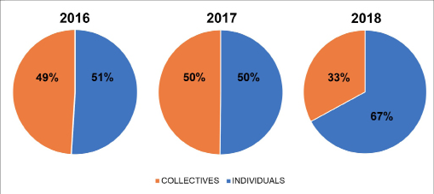doxa.comunicación | nº 28, pp. 17-36 | 31
January-June of 2019
Juan Luis Manfredi Sánchez and Luis Mauricio Calvo Rubio
ISSN: 1696-019X / e-ISSN: 2386-3978
The study of information related to each of the projects selected in the final phase has allowed us to gain knowledge as to whether the proposals have been made on an individual basis or as a group. During the first two years studied, the percentage of the former and the latter was nearly equal, as can be seen in Table 5.
Table 5. Percentage of proposals selected that were submitted by groups or individual citizens during the 2016, 2017 and 2018 participatory budgets.
Source: www.decide.madrid.es. Prepared by the authors.
In 2016, individual proposals represented 51%, compared to 49% for collective proposals. In the latter group, more than half (51%) came from spaces and participative forums of the various districts. The rest came from a wide range of organisations: neighbourhood associations, sports entities, cultural associations, support groups, parent associations, and associations of local governments or political groups.
In 2017, the similarity between selected projects submitted by individual citizens (50%) and those supported by a group (50%) continued. In this case, proposals arising from the participation spaces of the districts accounted for 49% of the collective projects. Once again, behind the remainder were associations from different fields, sports clubs, schools, etc.
However, in 2018 there was a considerable increase in the number of individual proposals: while 33% were endorsed by a group, 67% came from individual citizens. Of the former, 53% were from different participation bodies promoted in each district (citizen participation roundtables, forums, etc.).
4. Conclusions
The Madrid City Council’s participatory budgets were launched in 2016 following similar initiatives in Europe to encourage citizen participation in the distribution of limited public resources.
After three years, the figures show growing citizen interest in participating in this process, as the number of people taking part in them has nearly doubled. However, despite this significant increase, we see that in absolute percentages,
